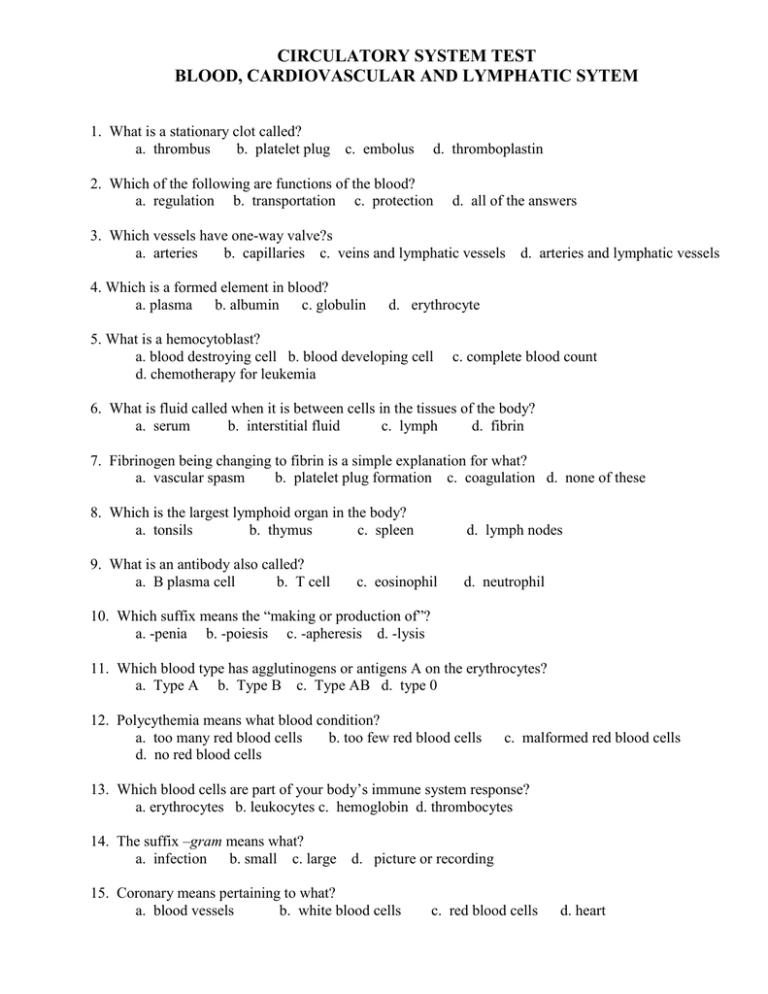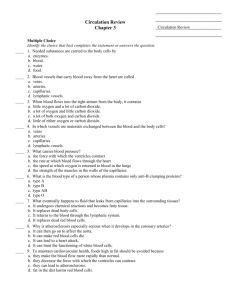File - andrus medical anatomy and physiology
advertisement

CIRCULATORY SYSTEM TEST BLOOD, CARDIOVASCULAR AND LYMPHATIC SYTEM 1. What is a stationary clot called? a. thrombus b. platelet plug c. embolus d. thromboplastin 2. Which of the following are functions of the blood? a. regulation b. transportation c. protection d. all of the answers 3. Which vessels have one-way valve?s a. arteries b. capillaries c. veins and lymphatic vessels 4. Which is a formed element in blood? a. plasma b. albumin c. globulin d. arteries and lymphatic vessels d. erythrocyte 5. What is a hemocytoblast? a. blood destroying cell b. blood developing cell d. chemotherapy for leukemia c. complete blood count 6. What is fluid called when it is between cells in the tissues of the body? a. serum b. interstitial fluid c. lymph d. fibrin 7. Fibrinogen being changing to fibrin is a simple explanation for what? a. vascular spasm b. platelet plug formation c. coagulation d. none of these 8. Which is the largest lymphoid organ in the body? a. tonsils b. thymus c. spleen d. lymph nodes 9. What is an antibody also called? a. B plasma cell b. T cell d. neutrophil c. eosinophil 10. Which suffix means the “making or production of”? a. -penia b. -poiesis c. -apheresis d. -lysis 11. Which blood type has agglutinogens or antigens A on the erythrocytes? a. Type A b. Type B c. Type AB d. type 0 12. Polycythemia means what blood condition? a. too many red blood cells b. too few red blood cells d. no red blood cells c. malformed red blood cells 13. Which blood cells are part of your body’s immune system response? a. erythrocytes b. leukocytes c. hemoglobin d. thrombocytes 14. The suffix –gram means what? a. infection b. small c. large d. picture or recording 15. Coronary means pertaining to what? a. blood vessels b. white blood cells c. red blood cells d. heart 16. Pertaining to heart and blood vessels is what word? a. coronary sinus b. coronary arteries c. cardiovascular 17. Hemolytic means pertaining to what? a. making blood b. destruction of blood c. study of blood d. circulatory d. blood condition 18. The “lub” and “dub” sound of the heart are caused by what? a. conduction system of the heart b.coronary sinus c. coronary arteries d. heart valves closing 19. If you have a low number of white blood cells you are said to have what? a. leukocytosis b. few leukocytes c. leukopenia d. net cells 20. What molecule on a RBC carries oxygen and gives blood it’s red color? a. platelets b. fibrinogen c. hemoglobin molecules d. reticulocytes 21. Which of these blood cells clot blood? a. erythrocytes b. eosinophils c. thrombocytes d. monocytes 22. Which term means “blood standing still” or the stoppage of bleeding? a. thrombocytopenia b. hemostasis c. thromboplastin d. hemocytoblast 23. What does the suffix -emia mean? a. removal of b. deficiency of c. blood condition d. tumor 24. Which formed element of blood carries oxygen? a. erythrocyte b. leukocyte c. thrombocyte d. eosinophil 25. The branch of science concerned with the study of blood, blood-forming tissue, and the disorders associated with them is called what? a. hematology b. cardiology c. blood science d. lymph science 26. The prefix poly means what? a. anger b. few c. many d. condition of 27. What is a traveling clot called? a. thrombus b. platelet plug c. embolus d. thromboplastin 28. To prevent the backflow of blood in the heart, the heart has what? a. pericardium b. chambers c. veins d. valves 29. Blood from lower part of the body flows into the right atrium through what? a. superior vena cava b. inferior vena cava c. coronary sinus d. none of the answers 30. The arteries that carry deoxygenated blood away from the heart and towards the lungs are called what? a. aorta b. brachiocephalic c. superior vena cava d. pulmonary 31. The wall of the heart has its own blood vessels that bring it oxygen. These come off of the aorta and are called what? a. coronary veins b. coronary arteries c. aorta d. superior vena cava 32. Which part of the heart has the most muscle around it’s chamber and pumps blood to the entire body? a. right ventricle b. left ventricle c. right atrium d. left atrium 33. carry blood towards the heart and carry it away from the heart. a. arteries, veins b. veins, arteries c. atria, ventricles d. ventricles, atria 34. The valve between the right atrium and right ventricle is what? a. bicuspid b. mitral c. tricuspid d. semilunar 35. The medical specialty that deals with the heart and its disorders is called a. heartology b cardio physiology c. cardio pathology d. cardiology 36. Which of the following is NOT part of the conduction system of the heart? a. AV valve b. Purkinje fibers c. SA node d. Bundle branches e. AV node 37. Fluids in veins and lymphatic vessels are transported with help from what? a. heart contraction b. digestion c. water retention d. muscle movement 38. In tonsilitis, what is happening to the tonsils? a. inflammation b. removal c. nothing d. dysfunction 39. The lymphatic system has what to make sure the lymph capillaries close and don’t leak? a. anchors b. valves c. lymph nodes d. ducts 40. Lymphatic vessels are most like what? a. arteries b. veins c. capillaries d. none of the answers 41. Which lymphatic organ is like a school for T-cells and is larger in children than adults? a. spleen b. appendix c. tonsils d. thymus 42. Which pulmonary vessel carries blood from the lungs to the heart? a. pulmonary vein b. pulmonary trunk c. pulmonary artery d. all of the answers 43. The endocardium is “pertaining to” what part of the heart? a. inner layer b. myocardium c. valves d. blood flow through the heart 44. How long do red blood cells last in your bloodstream? a. ten days b. four months c. ten months d. four years 45. The QRS complex on an electrocardiogram is a recording of what? (the high peak of contraction) a. atrium contracting b. ventricles contracting c. atrium relaxing d. ventricles relaxing 46. The valve between the left atrium and the left ventricle is known as the a. tricuspid b. pulmonary semilunar c. aortic semilunar d. bicuspid 47. What is called the pacemaker of the heart? a. SA node b. AV node c. bundle of His d. Purkinje fibers 48. Blood pressure is measured when the heart contracts and blood extends the arteries. What is this? a. diastole b. systole c. sphygmomanometer d. electrocardiogram 49. Which vessels are responsible for gas and nutrient exchange with each body cell? a. arterioles b. venules c. capillaries d. aorta 50. Which term refers to the relaxation of the chambers of the heart? a. systole b. diastole c. arrhythmia d. cardiac output 51. What is used to measure the electrical activity of the heart? a. sphygmomanometer b. electrocardiogram c. echocaridogram d. plasmapheresis 52. Sickle cell anemia causes which cell to stiffen so it can’t carry oxygen and may block capillaries? a. WBC’s b. RBC’s c. platelets d. it doesn’t effect blood cells 53. A foreign particle entering the body is referred to as what? a. antibody b. antigen c. phagocyte d. lymphocyte 54. The suffix -odynia means what? a. ordinary b. away c. pain d. heart sound 55. If a person has a slow heart beat they would be said to have what? a. cardiac arrest b. bradycardia c. tachycardia d. MI 56. The root word macr/o means what? a. large b. small c. blockage d. narrowing 57. Circulation going through the lungs is called what? a. systemic b. pulmonary c. cardiac d. lymphatic 58. How many beats of your heart per minute is called what? a. stroke volume b. cardiac output c. heart rate d. systole e. diastole 59. Production of lymphoid stem cells in the red bone marrow is called what? a. hemostasis b. hemopoeisis c. blastocytosis d. lymphopoeisis 60. A rapid heart rate would be called what? a. bradycardia b. arrythmia c. tachycardia 61. Which suffix means blood condition? a. –oma b. –osis c. –emia d. cardiodynia d. –al 62. The middle layer of the heart, the actual muscle is called what? a. myocardium b. epicardium c. endocardium d. septum 63. Between the ventricles is which of the following words? a. intraventricular b. epiventricular c. endoventricular d. interventricular 64. If you have type O blood you can safely receive transfusions from which blood types? a. type AB only b. type O only c. any type d. types A and B 65. Phagocytosis means what is happening to cells? a. they are being poisoned b. they are being ingested or eaten c. nothing d. they are dividing For 66-71 use these answers. a. cardiovascular 66. 67. 68. 69. 70. 71. b. lymphatic c. both lymphatic & cardiovascular d. none of the answers transport substances have three layers in vessels have anchors in capillaries are aided in movement by muscle movement get help from heart pumping aid in breathing For 73-85 use these answers. a. arteries 72. 73. 74. 75. 76. 77. 78. 79. 80. b. veins c. capillaries d. all three, arteries, veins and capillaries e. none of the answers have small cavities and great pressure carry deoxygenated blood except for pulmonary have lumen or space carry oxygenated blood except for pulmonary carry blue blood are superficial in the body are deep in the body have one layer small enough for one cell to pass TURN SCANTRON OVER FOR BONUS DO THE BONUS IN THE COMPLETION SECTION BONUS: 1. 2. 3. 4. List, in order, the vessels that branch off of the aortic arch. What does this formula mean? SV X HR = CO What is the name of the blood pressure cuff and what is the adult average blood pressure? What does MALT stand for? Name any MALT organs.




